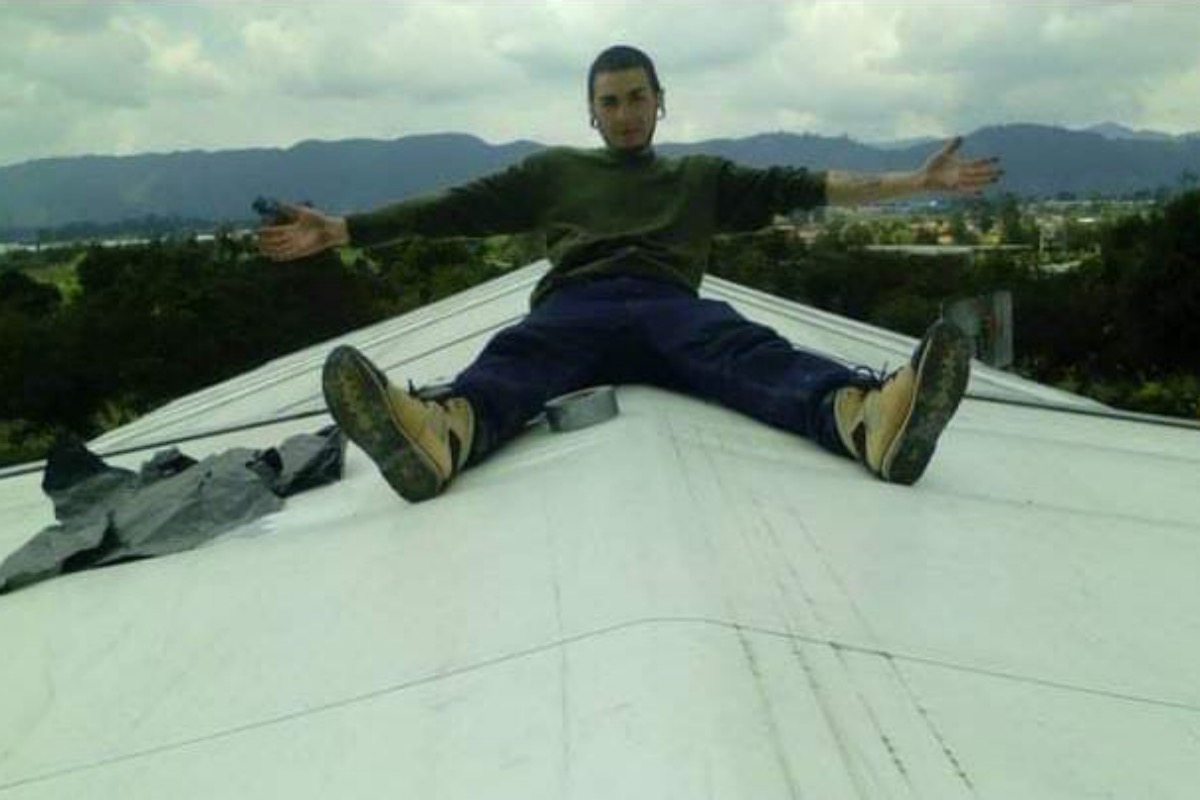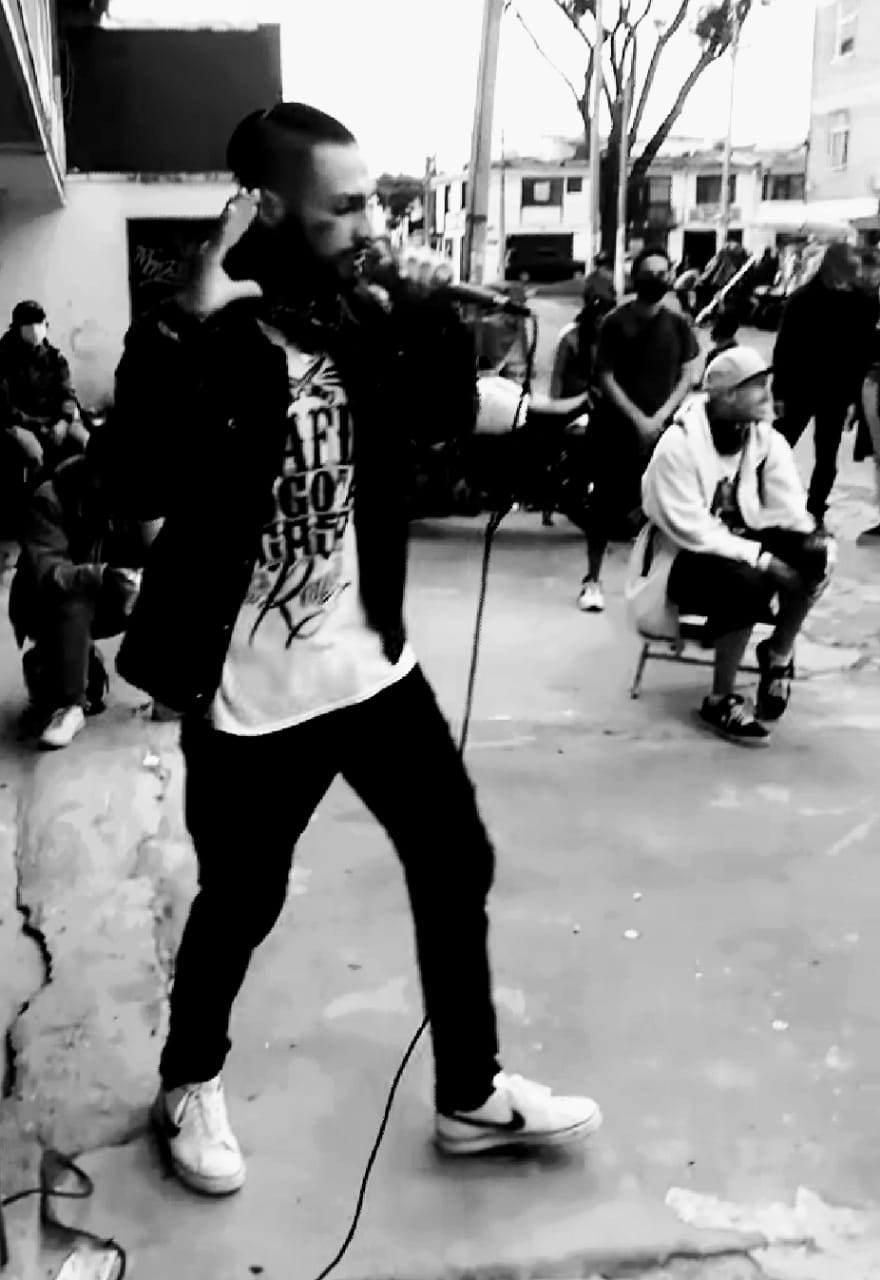

Sergio Pastor, who goes by the name “19,” is a hip-hop artist and activist currently facing life in prison for his participation in last year’s National Strike in Colombia (Courtesy of Lorena González)
BOGOTÁ, Colombia — The last time Lorena González saw her son free was one morning during Colombia’s National Strike last summer.
“Mom, I won’t go back because my struggles are in the streets. Give me your blessing and pray a lot,” said Sergio Pastor, 31, known in the mobilizations as “19” for the code of the neighborhood where he grew up, Ciudad Bolívar, a place marked by poverty and stigma.
Sergio is an avatar for the neighborhood in the south of Bogotà: a hungry young man with tattoos on his face, dreadlocks, and some minor offenses. His image condemned him in the media long before his capture.
The day he said goodbye to his mother, he hugged her, told her he loved her, and before leaving the house, reminded her that he was doing it for her too.
It was four in the morning in July 2021. Sergio carried the damaged metallic shield that he used to defend himself against the police offensive in Portal Resistencia, a point in Bogotá that, due to the fierce resistance of the protesters, the authorities never came to control during the protests.
A photo of him with his shield enduring the jet of water from a police tank made him a leader in the mobilizations. But in the media’s narrative, he’s a criminal.
Why Did He Protest?
Sergio’s story is like that of another 300 young people incarcerated today for crimes that occurred during the National Strike, according to the Attorney General’s Office. Human rights organizations say they are victims of persecution and the criminalization of social mobilization.
“We live what poverty is, the lack of opportunities,” Lorena told Latino Rebels. “What it is like for a young person at 11 years old to go out to work to help at home.”
Sergio is the eldest of four brothers, and with his mother, the head of the household, he had to take whatever work he came along. He was a construction worker, installed scaffolding at events, and when the pandemic hit and he lost his job, he went to rapping on public buses. He never stopped looking for resources. And just like her mother had before her, Lorena slept under a bridge and recycled garbage so she could feed her children.
Sergio’s hip hop was infused with political consciousness. His first songs at the bus stops had messages of change and awareness in the face of the harsh reality that he and his fellow Colombians lived every day.


Sergio Pastor, a.k.a. “19,” rapping on a street in Bogotá, Colombia. (Courtesy of Lorena González)
When the protests broke out in 2021, he knew his place was in the streets. His physical strength and speech made him visible among the youth of Portal Resistencia.
“My son Sergio is a great human being,” Lorena said. “Other people’s things affect him too much, like stories of hunger, of poverty.”
One morning, after three months of protests, he called her and asked her to meet in the afternoon. But the call Lorena later received was to inform her that her son had been detained.
“You feel that the world is collapsing,” she recalled. “I thought, could it be that they had disappeared him? Could it be that they shut him up?”
The authorities refer to Sergio as if he were the leader of a criminal organization, accusing him of conspiracy to commit a crime and torture. He could face a sentence of up to 40 years in prison.
The facts of his case, however, remain unclear.
According to the prosecutor’s office, during the three months of protests, Sergio met with other leaders to arrange a series of crimes, including an attack on two people who were accused of being infiltrated by police and before being tied to a post and beaten.
His defense attorney, Andrea Torres, says there is no evidence that he has met with the other detainees to plan the crimes. Nor is evidence that he himself participated in them.
“My son Sergio is being prosecuted as a common criminal and is stigmatized because he has tattoos on his face and appears in several videos speaking and giving conscience talks,” Lorena said. “When they captured him, several media outlets made him look like a terrorist.”
For Torres, Sergio’s image facilitated the prosecution. His tattoos and his way of speaking have served to make him the focus of general stigmatization against Ciudad Bolívar and the protesters.
‘They Took Him in Good Health, and That’s How They Have to Give Him to Me.’
The persecution did not end with his capture. Sergio was transferred to the most brutal prison in Colombia, the Tramacúa, a maximum-security facility designed under United States prison standards, in a hot desert area in northern Colombia, where the average temperature exceeds 100 degrees Fahrenheit.
While exercising, a device fell on him and fractured several ribs. He could not move his right arm and had difficulty moving his neck.
In a video leaked on social networks, a wounded Sergio was taken by security guards and forced to attend a court hearing. With tears in his eyes, he begged the judge to suspend the hearing and allow him medical attention.
“The only thing that mattered to the judge was whether he pleaded guilty or not guilty. It is not only stigmatization but also dehumanization,” Lorena said. “They took him in good health, and that is how they have to give him to me.”
The Criminalization of Colombia’s Social Movement
Sergio’s trial is currently in the oral trial stage, progressing despite a clear lack of evidence. His mother believes he will be sentenced in October.
The prosecutor’s office claims that Sergio was part of the Primera Línea (First Line, or PL) to the south of Bogotá, a group of young people who organized themselves during the protests to defend demonstrators and mobilization sites. Authorities say the PL is a group outside the law that came together with the sole purpose of committing criminal acts, such as the destruction of public and private property, committing torture, and attacking public servants.
The prosecutor’s office typifies has classified the alleged attacks committed by Sergio not as simple assault or batter, but as torture—which, in a country with a long history of armed conflict like Colombia, carries one of the maximum penalties.
The prosecutor who built the case against Sergio was not typical but was part of the Office Against Organized Crime, created after the Havana peace agreement that ended the 50-plus year conflict between the Colombian government and the Fuerzas Armadas Revolucionarias de Colombia.
“I am part of a foundation that works to defend human rights victims,” said Torres, Sergio’s defense attorney.”Getting crimes committed by the guerrillas or paramilitaries is tough to reach that unit, which is a specialized unit for terrorism issues. One does not explain how a case like this of young people ends up there.”
Torres says that time is working against them.
“They sought to generate panic in front of the entire population, because a crime of torture gives you a sentence of 40 years in prison. And if you put a young man in jail for 40 years, you end his life,” she explained.
All kinds of irregularities have occurred during the hearings. The judge has confused 19’s alias with M-19, an old guerrilla from the 1980s, and some of the witnesses who have taken the stand to testify Sergio are officers specialized in the fight against terrorism.
Erika Prieto, a human rights defender of the campaign Being a Social Leader Is Not a Crime, explains that more than 300 people have been prosecuted for participating in the National Strike. Many of them are persecuted under the same strategy used against Sergio.
“There is no transparent exercise of criminal prosecution. They look for deeply troublesome behaviors and put them in the National Strike framework… Terrorism, torture, kidnapping, and that makes them very serious accusations, which do not correspond to reality,” he explained.
And Sergio’s case is not the only one. According to information received from the prosecutor’s office, there are 88 young people indicted for terrorism and 51 for the crime of torture.
‘I Am Proud to be a Mother of a First Line’
Lorena, who works cleaning houses in Bogotá’s wealthy neighborhoods, has had to resort to loans to be able to travel to northern Colombia to visit her son. It’s an expensive trip, so she has only been able to go twice.
She tries to stay strong in front of her son, who is sinking further into depression. “He says that he was left useless, that the only thing that fills him with joy is knowing that a change got achieved,” she said.
Thanks to the social mobilizations, most of Colombia voted for the first time for a leftist government, the first in Colombia’s history, that supports the movement. Today, a proposal is working its way through Congress that would provide amnesty for young people imprisoned for their participation in the National Strike. But those against the proposal remain in the majority.
“I am proud to be a mother of a First Line because the revolution was the step for change,” Lorena said. “Does it hurt? Yes. But we had no other way.”
***
David González M. is an award-winning conflict and human rights reporter for international media. Twitter: @Davo_gonzalez



[…] post The Story of 19: Protest Leader Faces Life Sentence in Colombia appeared first on Latino […]
Oh come on! This violent criminal is where he needs to be! Enough gibberish about so—called “protesters”.